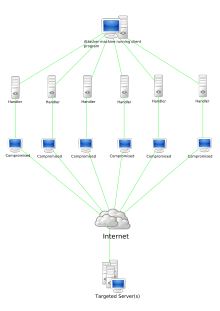One common method of attack involves saturating the target machine with external communications requests, such that it cannot respond to legitimate traffic, or responds so slowly as to be rendered effectively unavailable. In general terms, DoS attacks are implemented by either forcing the targeted computer(s) to reset, or consuming its resourcesso that it can no longer provide its intended service or obstructing the communication media between the intended users and the victim so that they can no longer communicate adequately. Denial-of-service attacks are considered violations of the IAB's Internet proper use policy, and also violate the acceptable use policies of virtually all Internet service providers. They also commonly constitute violations of the laws of individual nations.[2] A denial-of-service attack (DoS attack) or distributed denial-of-service attack (DDoS attack) is an attempt to make a computer resource unavailable to its intended users. Although the means to carry out, motives for, and targets of a DoS attack may vary, it generally consists of the concerted efforts of a person or people to prevent an Internet site or servicefrom functioning efficiently or at all, temporarily or indefinitely. Perpetrators of DoS attacks typically target sites or services hosted on high-profile web servers such as banks, credit cardpayment gateways, and even root nameservers. The term is generally used with regards tocomputer networks, but is not limited to this field, for example, it is also used in reference toCPU resource management.[1]
A denial-of-service attack (DoS attack) or distributed denial-of-service attack (DDoS attack) is an attempt to make a computer resource unavailable to its intended users. Although the means to carry out, motives for, and targets of a DoS attack may vary, it generally consists of the concerted efforts of a person or people to prevent an Internet site or servicefrom functioning efficiently or at all, temporarily or indefinitely. Perpetrators of DoS attacks typically target sites or services hosted on high-profile web servers such as banks, credit cardpayment gateways, and even root nameservers. The term is generally used with regards tocomputer networks, but is not limited to this field, for example, it is also used in reference toCPU resource management.[1]
Monday, December 6, 2010
DDoS - Distributed Denial-of-service
Subscribe to:
Post Comments (Atom)
No comments:
Post a Comment